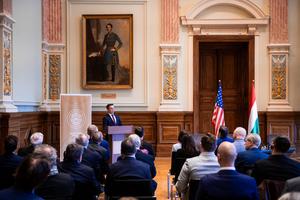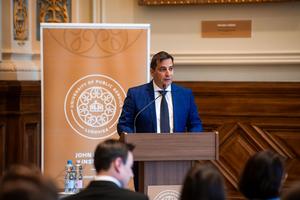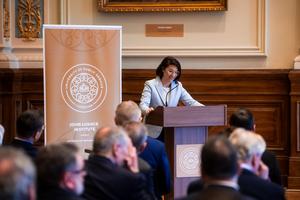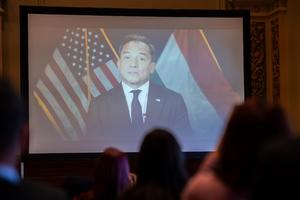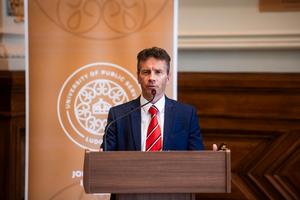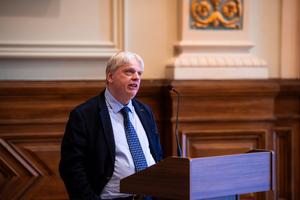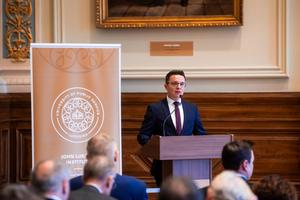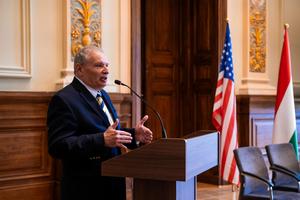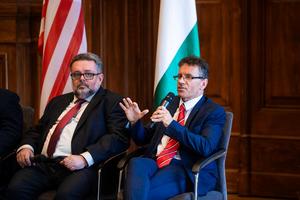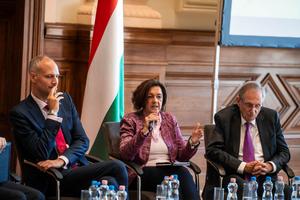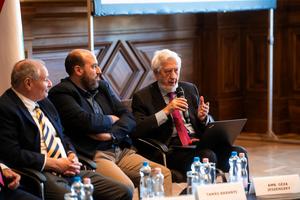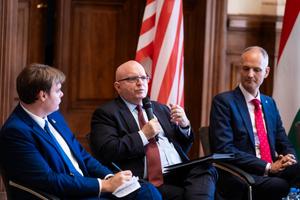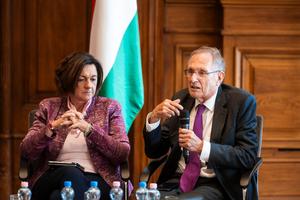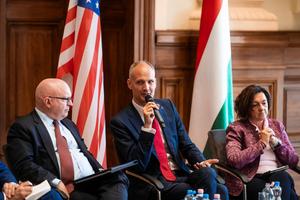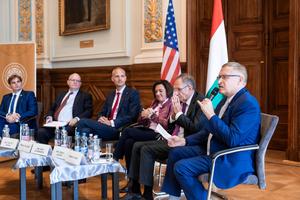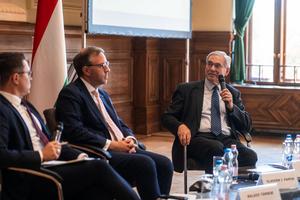This year marks the 100th anniversary of the Treaty of Friendship, Commerce, and Consular Rights between the United States and Hungary. To commemorate the occasion, the John Lukacs Institute for Strategy and Politics (JLI) of the Eötvös József Research Centre at Ludovika University of Public Service (LUPS), in cooperation with the U.S. Embassy in Budapest, the Hungary Foundation, and the Hungarian–American Fulbright Commission, organized an international conference on October 7 in the University’s Széchenyi Hall.
The aim of the event was to appropriately commemorate the Treaty of Friendship, Commerce, and Consular Rights, signed in Washington, D.C. on June 24, 1925 — a historic milestone in official relations between the two nations. The conference not only sought to review a century of diplomatic, political, and economic cooperation but also to address the challenges and opportunities of the present and the future.
In his welcoming remarks, Gergely Deli, Rector of Ludovika University of Public Service, emphasized the university’s threefold mission. First, the University is deeply committed to the idea of good governance, built upon collaboration among various branches of public service and international partnerships. Accordingly, the University considers it both a privilege and a duty to host an event where experts, government officials, and diplomats, who support successful bilateral cooperation, can share their insights on the development and milestones of U.S.–Hungarian relations. The second pillar of the University’s mission is academic excellence — to serve as a hub of knowledge in security, public administration, diplomacy, and many other disciplines. This multidisciplinary profile is well reflected by the John Lukacs Institute for Strategy and Politics, whose research focuses on the political, security, and economic dynamics of the United States and transatlantic relations, as well as China and the Indo-Pacific region, with particular attention to strategic and defense considerations. Finally, the University’s mission also lies in serving the common good — utilizing its academic and research capacities for noble purposes that advance the public interest. This is achieved through partnerships that highlight Hungarian efforts and scientific achievements in the spirit of professional excellence and in service of the common good. In accordance with the above, Rector Deli noted that the Széchenyi Hall of the Ludovika Campus was a fitting venue for the commemoration: the Hungarian signatory of the 1925 Treaty, Count László Széchenyi, was the grandson of Count Lajos Széchenyi, who had financially supported the establishment of the Ludovika Academy.
Robert Palladino, Chargé d’affaires at the U.S. Embassy in Budapest, addressed the audience via video message. He emphasized that the 1925 Treaty was not merely a diplomatic agreement but a declaration of shared values and a commitment to partnership between the two nations. Accordingly, he emphasized that the most important word in the treaty’s title is friendship — signaling that the bond between the United States and Hungary is not only political or transactional but also civilizational in nature. Although the two countries were not always on the same side during the past century, Palladino recalled that people-to-people ties endured even during difficult times. He cited, among others, the U.S. reception of Hungarian refugees in 1956, the asylum granted to Cardinal József Mindszenty, the return of the Holy Crown to the Hungarian people, and President George H. W. Bush’s visit to Budapest in 1989. He added that the American–Hungarian partnership rests on enduring principles — freedom, faith, family, and sovereignty — which continue to inspire cooperation today. Looking to the future, he underlined the importance of energy security, national sovereignty, and investments that create jobs and prosperity, encouraging a renewal of the partnership. As he put it, “civilizational allies like the United States and Hungary do more than sign treaties or meet bureaucratic benchmarks. We invest in one-another, we defend one-another.” Charge d’affaires Palladino reminded that if both nations remain faithful to the principles of sovereignty, prosperity, and mutual respect, the relationship will not only endure but flourish in the future.
Boglárka Illés, State Secretary for Bilateral Relations at the Ministry of Foreign Affairs and Trade of Hungary, offered a Hungarian perspective on the friendship between the two countries. She underlined that the U.S.–Hungarian relationship is grounded in shared values — freedom, independence, and national identity — and that current global challenges such as security threats, humanitarian crises, and economic issues can only be addressed through cooperation. She noted that 2025 marks the beginning of a “new golden era” in bilateral relations, which is not merely as a slogan but a reflection of reality. Accordingly, State Secretary Illés expressed her confidence that the future of the U.S.–Hungarian partnership will continue to rest on mutual trust and respect.
The first panel of the conference was titled “Hungarian–American Relations in the First Half of the 20th Century” and was moderated by Balázs Tárnok, Director of Research at the John Lukacs Institute for Strategy and Politics. Gábor Bátonyi, Assistant Professor at the University of Bradford, opened the session with a lecture titled “The Anglo-Saxon World and the Liquidation of Austria–Hungary.” He recalled that early 20th-century British and American leaders viewed the Dual Monarchy as an empire in decline. In December 1914, President Woodrow Wilson predicted that “Austria–Hungary will completely fall apart — and in a certain sense it must, for the good of Europe.” Bátonyi noted that for the United States, friendship with the Habsburg Empire was a source of concern, as it was closely tied to the problem of mass emigration. He also explained that strong Russian influence prevailed in both Britain and the United States, and neither sought direct confrontation with Russia until 1918. Later, the Anglo-American perception of the Habsburg legacy oscillated, sometimes being reassessed more favorably.
Tibor Glant, Research Professor at the John Lukacs Institute for Strategy and Politics, and Assistant Professor at the University of Debrecen, spoke on “Creating a Modus Operandi: Setting up U.S.–Hungarian Bilateral Relations.” He explained that although the two countries were formally at war between 1917 and 1921, there was no actual fighting between them. Diplomatic relations were reestablished between 1921 and 1925, when the United States gradually — though cautiously — recognized Hungary’s independence, culminating in the signing of the Treaty of Friendship, Commerce, and Consular Rights. Glant emphasized that the relationship was marked by asymmetry: for Hungary, the United States was a strategic partner, while for the U.S., Hungary remained largely a regional issue. The modern U.S.–Hungarian partnership, he concluded, was built step by step out of postwar chaos, grounded in friendship, independence, and mutual respect.
Zoltán Peterecz, Associate Professor at Eszterházy Károly Catholic University, in his presentation “American Ministers in Hungary between the Wars,” explored how U.S. envoys — Theodore Brentano, Nicholas Roosevelt, John F. Montgomery, and Herbert Pell — perceived Hungary and the Hungarian people during the interwar period. He noted that these American representatives were not career diplomats but political appointees, often with limited experience yet significant personal ambition.
László Borhi, Professor and Peter A. Kadas Chair at Indiana University, delivered a keynote lecture titled “American–Hungarian Relations During the Cold War.” He analyzed how Hungary’s foreign policy depended on the dynamics of U.S.–Soviet relations. Between 1945 and 1990, Hungary was sovereign only in name, under de facto Soviet influence. Consequently, U.S.–Hungarian relations were largely a function of superpower relations. While the U.S. pursued a policy of containment after 1947, it remained open toward Hungary: through American mediation, Hungary recovered its gold reserves, and U.S. pressure helped prevent the complete expulsion of ethnic Germans and Hungarians. After 1948, however, with the Berlin Blockade and Soviet expansionism, the U.S. shifted to a policy of isolation toward communist regimes. The bilateral relationship remained distant but gradually normalized until the end of the Cold War.
In the following panel discussion, “American–Hungarian Relations in the Cold War Era and the Regime Change” moderated by Tibor Glant, panelists László Borhi, Géza Jeszenszky (former Minister of Foreign Affairs of Hungary), and Tamás Baranyi (Director for Strategy, Hungarian Institute of International Affairs) discussed the key developments from the late Cold War through the democratic transition. They highlighted the impact of President George H. W. Bush’s 1989 visit to Budapest, which symbolized Hungary’s decisive orientation toward the West. The discussion also touched on Hungary’s accession to NATO under President Bill Clinton’s administration. The panelists agreed that although the two nations were sometimes politically opposed, the U.S. consistently maintained a sympathetic attitude toward Hungary.
The panel discussion titled “American–Hungarian Relations Today” focused on the evolution of bilateral relations in the decades following the regime change, as well as on the most recent developments and future prospects. The discussion was moderated by Gábor Csizmazia, Head of the America Research Program at the John Lukacs Institute for Strategy and Politics. The participants examined various dimensions of the relationship — diplomatic, security, economic, and cultural alike. Amb. Philip T. Reeker, Partner at Albright Stonebridge Group Europe & Eurasia and former Deputy Chief of Mission at the U.S. Embassy in Budapest, offered a historical overview based on his personal experiences in Hungary since 1989. The former diplomat highlighted how U.S. foreign policy toward Central Europe had evolved from the Cold War to the present— from supporting democratic transformation, through the post-9/11 focus on counterterrorism, to the “America First” approach of the Trump era. Márton Ugrósdy, Deputy State Secretary at the Prime Minister’s Office, emphasized the importance of security guarantees, especially in the current European security environment, while also recalling the significance of economic relations between the two countries. Two former Hungarian ambassadors to Washington, D.C. also took part in the panel: Amb. Réka Szemerkényi, Director of International Affairs at the Equilibrium Institute, drew attention to the geopolitical changes of recent years and their security implications, whereas Amb. György Szapáry, Chief Advisor to the President of the National Bank of Hungary, underlined the importance of American investments as well as of the broader economic relations between the European Union and the United States. Károly Jókay, Executive Director of the Hungarian–American Fulbright Commission, stressed the vital role of cultural and educational relations. He noted that the Hungarian government’s financial contribution to the Fulbright Program had increased sevenfold between 2022 and 2025. He added that one of the program’s essential goals is to ensure that its participants act as cultural ambassadors of their countries, thereby promoting mutual understanding and respect between the two nations.
The closing session, “The Future of American–Hungarian Relations,” moderated by Balázs Tárnok, featured Gladden J. Pappin, President of the Hungarian Institute of International Affairs, and Amb. Tamás Magyarics, Professor Emeritus at Eötvös Loránd University. President Pappin noted that while U.S.–Hungarian relations remain strong, the international order is undergoing profound transformation. The liberal world order is weakening, and the United States increasingly defines its foreign policy based on national interests, focusing inward on domestic renewal. Hungary, he argued, can identify with this sovereign, self-reliant approach to security and statecraft. Professor Magyarics added that although Hungary is no longer the United States’ primary regional partner — a role now more associated with Poland and Romania — military cooperation remains excellent, and Hungary has significantly increased its defense spending. Despite differing perceptions of the war in Ukraine, both countries share the strategic goal of achieving peace as soon as possible. Future U.S. domestic political developments, he suggested, may shape the direction of bilateral relations, but the current positive atmosphere is likely to persist.
Text: Éva Harangozó
Translation: John Lukacs Institute for Strategy and Politics
Photos: Dénes Szilágyi
